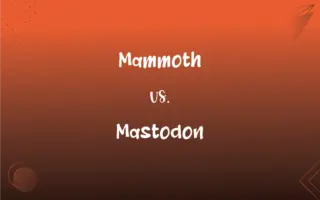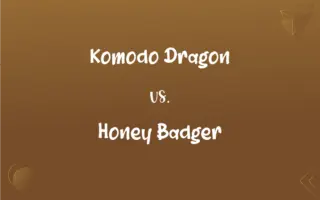Earthworm vs. Leech: What's the Difference?
Edited by Harlon Moss || By Janet White || Published on October 22, 2023
A tube-shaped, segmented worm that enriches soil through its burrowing and excretion. A parasitic or carnivorous worm with suckers at both ends for attaching to its host. Earthworms benefit soil ecology, while leeches are oft

Key Differences
The earthworm is commonly recognized for its role in enhancing soil fertility. Its activity in the soil promotes aeration and nutrient distribution, favoring plant growth and health. On the contrary, the leech is largely known for its parasitic nature in many species, attaching to hosts, which may be humans or other animals, to feed on their blood. Here, the essential distinction lies in their respective ecological roles and feeding habits, demonstrating the divergence between benevolence and parasitism.
Inhabiting varied environments, earthworms are largely found in soil, making substantial contributions to composting and natural soil processes. Leeches, while also inhabiting various environments, can often be found in aquatic settings or moist environments, and their presence may be unwelcome to those who encounter them due to their parasitic tendencies. While both can thrive in moist habitats, their interactions with their respective environments and other organisms fundamentally differ.
Earthworms utilize organic material in the soil for nutrition, inadvertently contributing to soil improvement and nutrient cycling. Conversely, leeches seek out hosts, using their suckers to adhere to them, facilitating a blood meal. Earthworms are typically harmless and avoid interaction with humans, while leeches, specifically the parasitic varieties, seek out hosts, including humans, to feed upon, demonstrating contrasting interactions with other species.
The earthworm’s physical structure is streamlined, without apparent limbs or prominent features, purely functional for burrowing and consuming decomposed matter. Meanwhile, leeches possess anti-coagulant properties in their saliva, ensuring a free flow of blood from their feeding source. The physical attributes of each worm-type are adapted to their environmental interactions and feeding requirements, underpinning their physiological and functional distinctions.
In cultural and scientific contexts, earthworms often symbolize a healthy environment and are utilized in vermicomposting. Leeches, historically and currently, have been employed in medical contexts for treatments like bloodletting and in certain therapeutic applications. Their roles in human activities and scientific applications vary significantly, further emphasizing the dichotomy in human perception and utility regarding earthworms and leeches.
ADVERTISEMENT
Comparison Chart
Habitat
Primarily in soil
Aquatic/moist areas
Feeding Habits
Detritivore
Parasitic/Carnivorous
Interaction with Humans
Largely indirect/beneficial
Direct, can be parasitic
Role in Environment
Improve soil structure
Often no benefit, can be a pest
Use in Human Activities
Vermicomposting, symbolic of healthy soil
Medical and therapeutic uses
ADVERTISEMENT
Earthworm and Leech Definitions
Earthworm
Detritivores
Earthworms are detritivores, consuming dead organic matter.
Leech
Parasitic
Some leeches are parasitic, feasting on the blood of hosts.
Earthworm
Burrowers
The earthworm burrowed through the nutrient-rich soil.
Leech
Anticoagulant
Leech saliva contains an anticoagulant to prevent blood clotting during feeding.
Earthworm
Ecological Helpers
Earthworms serve as ecological helpers by naturally aerating soil.
Leech
Aquatic
Many leech species inhabit aquatic environments, gliding through the water in search of hosts.
Earthworm
Segmented
An earthworm's body is segmented, facilitating its burrowing motion.
Leech
Any of various chiefly aquatic carnivorous or bloodsucking annelid worms of the class (or subclass) Hirudinea, of which one species (Hirudo medicinalis) was formerly widely used by physicians for therapeutic bloodletting.
Earthworm
Hermaphroditic
Earthworms are hermaphroditic, possessing both male and female reproductive organs.
Leech
One that preys on or clings to another; a parasite.
Earthworm
Any of various terrestrial annelid worms of the class Oligochaeta, especially those of the family Lumbricidae, that burrow into and help aerate and enrich soil.
Leech
(Archaic) A physician.
Earthworm
A worm that lives in the ground.
Leech
Either vertical edge of a square sail.
Earthworm
A worm of the family Lumbricidae, or, more generally, of the suborder Lumbricina.
Leech
The after edge of a fore-and-aft sail.
Earthworm
(figurative) A contemptible person; a groveller.
Leech
To bleed with leeches.
Earthworm
Any worm of the genus Lumbricus and allied genera, found in damp soil. One of the largest and most abundant species in Europe and America is L. terrestris; many others are known; - called also angleworm and dewworm.
Leech
To drain the essence or exhaust the resources of.
Earthworm
A mean, sordid person; a niggard.
Leech
To attach oneself to another in the manner of a leech.
Earthworm
Terrestrial worm that burrows into and helps aerate soil; often surfaces when the ground is cool or wet; used as bait by anglers
Leech
An aquatic blood-sucking annelid of class Hirudinea, especially Hirudo medicinalis.
Leech
(figuratively) A person who derives profit from others in a parasitic fashion.
Leech
A glass tube designed for drawing blood from damaged tissue by means of a vacuum.
Leech
(archaic) A physician.
Leech
(Germanic paganism) A healer.
Leech
(nautical) The vertical edge of a square sail.
Leech
(nautical) The aft edge of a triangular sail.
Leech
To apply a leech medicinally, so that it sucks blood from the patient.
Leech
To drain (resources) without giving back.
Bert leeched hundreds of files from the BBS, but never uploaded anything in return.
Leech
To treat, cure or heal.
Leech
See 2d Leach.
Leech
The border or edge at the side of a sail.
Leech
A physician or surgeon; a professor of the art of healing.
Leech, heal thyself.
Leech
Any one of numerous genera and species of annulose worms, belonging to the order Hirudinea, or Bdelloidea, esp. those species used in medicine, as Hirudo medicinalis of Europe, and allied species.
Leech
A glass tube of peculiar construction, adapted for drawing blood from a scarified part by means of a vacuum.
Leech
To treat as a surgeon; to doctor; as, to leech wounds.
Leech
To bleed by the use of leeches.
Leech
Carnivorous or bloodsucking aquatic or terrestrial worms typically having a sucker at each end
Leech
A follower who hangs around a host (without benefit to the host) in hope of gain or advantage
Leech
Draw blood;
In the old days, doctors routinely bled patients as part of the treatment
Leech
Suckers
Leeches use suckers to attach securely to their feeding source.
Leech
Medicinal Use
Historically, leeches were utilized in medicinal bloodletting practices.
FAQs
What do earthworms eat?
Earthworms consume soil, digesting organic matter within it and excreting enriched soil.
Are earthworms beneficial for gardens?
Yes, earthworms enhance soil fertility and structure, benefiting plant growth in gardens.
Can earthworms regenerate?
Some species of earthworm can regenerate small lost segments, but not entire halves.
Can both earthworms and leeches live in water?
Earthworms prefer terrestrial habitats, while some leeches can thrive in aquatic environments.
Where do earthworms live?
Earthworms primarily live in soil, especially in environments that are moist and rich in organic matter.
Are all leeches parasitic?
No, while some leeches are parasitic, others are predators or scavengers.
What is a leech?
A leech is a segmented worm, some species of which are parasitic, attaching to hosts to consume their blood.
What is an earthworm?
An earthworm is a tube-shaped, segmented organism known for its role in enriching soil.
Where are leeches found?
Leeches are found in various habitats, including fresh and saltwater bodies, and on land in moist environments.
What kind of movement do earthworms and leeches exhibit?
Both earthworms and leeches exhibit peristaltic movement, contracting and expanding their segmented bodies to move.
How do earthworms and leeches breathe?
Both earthworms and leeches breathe through their skin, requiring moist environments to facilitate gas exchange.
Do earthworms and leeches have eyes?
No, neither earthworms nor leeches have eyes, but they can sense light and changes in light intensity.
Can both earthworms and leeches be found globally?
Yes, various species of earthworms and leeches are found in diverse environments around the world.
Why were leeches used in medicine?
Leeches were historically used for bloodletting, a practice believed to balance the body’s humors.
Are earthworms and leeches related?
Yes, both earthworms and leeches belong to the phylum Annelida, making them distant relatives.
How do they reproduce?
Both earthworms and leeches are hermaphroditic and can reproduce by exchanging sperm with other individuals.
What role do earthworms and leeches play in food chains?
Earthworms often serve as food for various animals, while leeches can be both predators (or parasites) and prey within their ecosystems.
Can leeches be harmful to humans?
Generally, leech bites are not harmful but can cause discomfort, itching, and sometimes allergic reactions.
Are earthworms and leeches beneficial to ecosystems?
Earthworms are largely beneficial, while leeches can be either neutral, beneficial, or detrimental depending on the species and context.
How can I differentiate between an earthworm and a leech?
Earthworms typically have a smoother, more uniform body, while leeches have suckers on both ends and often appear more flattened.
About Author
Written by
Janet WhiteJanet White has been an esteemed writer and blogger for Difference Wiki. Holding a Master's degree in Science and Medical Journalism from the prestigious Boston University, she has consistently demonstrated her expertise and passion for her field. When she's not immersed in her work, Janet relishes her time exercising, delving into a good book, and cherishing moments with friends and family.
Edited by
Harlon MossHarlon is a seasoned quality moderator and accomplished content writer for Difference Wiki. An alumnus of the prestigious University of California, he earned his degree in Computer Science. Leveraging his academic background, Harlon brings a meticulous and informed perspective to his work, ensuring content accuracy and excellence.

































































